
A lychgate (from Old English līc, corpse) or resurrection gate[1] is a covered gateway found at the entrance to a traditional English or English-style churchyard. Examples also exist outside the British Isles in places such as Newfoundland,[2] the Upland South[3] and Texas[4] in the United States, Australia, New Zealand, South Africa, Norway,[5] and Sweden.
Etymology
The word lych survived into modern English from the Old English or Saxon word for "corpse", mostly as an adjective in particular phrases or names, such as lych bell, the hand-bell rung before a corpse; lych way, the path along which a corpse was carried to burial (this in some districts was supposed to establish a right-of-way); lych owl, the screech owl, because its cry was a portent of death; and lyke-wake, a night watch over a corpse (see Lyke-Wake Dirge).
It is cognate with the modern German Leiche, Dutch lijk and lichaam, West Frisian lyk and Swedish lik, all meaning "corpse".
Lychgate in Swedish is called stiglucka, literally "step hatch". The explanation is that the gate was split vertically so that you could step over the lower part without having to open it. Therefore, one can also guess another meaning of lych (lyke, luke, lucka "hatch, gap") from the Scandinavian languages.
Description
Lychgates consist of a roofed porch-like structure over a gate, often built of wood. They usually consist of four or six upright wooden posts in a rectangular shape. On top of this are a number of beams to hold a pitched roof covered in thatch or wooden or clay tiles. They can have decorative carvings and in later times were erected as memorials. They sometimes have recessed seats on either side of the gate itself, for the use of pall-bearers or vigil watchers.[6]
Lychgates followed a somewhat predictable pattern, though great variations in form could be seen. Typically, they were gable or hipped roofed, often with benches where mourners could sit, or with a lych-stone, coffin-stool or trestle, upon which a coffin could be rested.[7]
The most common form of lychgate is a simple shed composed of a roof with two gabled ends, covered with tiles or thatch. At Berrynarbor, Devon, there is a lychgate in the form of a cross, while at Troutbeck, Westmorland, there are three lychgates to one churchyard. Some elaborate gates have chambers over them. In Texas and the South of the US, lychgates are simpler in construction, usually consisting of a steel or wooden span with a sign showing the name of the burial space.[4]
Dates of surviving lychgates

Most were built from around the mid-15th century although some date from earlier, including the 13th-century lychgate of St George's churchyard in Beckenham, South London, claimed to be the oldest in England.[8] After World War I a number of lychgates were built as war memorials, for example that of Sandridge, Hertfordshire. Sandridge lychgate is a Grade II listed building as is that of St Cuthbert's, Allendale, Northumberland.[9] However, many of these memorial lychgates, such as that of St Peter's, Felkirk, Yorkshire, are not listed.[10] Several new examples were built to mark the new millennium, such as that at Lenton, Lincolnshire.
Use
In the Middle Ages, before mortuaries, and at a time when most people died at home, the dead were placed on a bier and taken to the lychgate where they remained, often attended against bodysnatchers, until the funeral service, which may have been a day or two later. The lychgate kept the rain off, and often had seats for the vigil watchers. Bodies at that time were buried in just shrouds rather than coffins. At the funeral, the priest conducted the first part of the service under the shelter of the lychgate.
In traditional usage, the gate was "the sheltered point at which the coffin was set down at a funeral to await the clergyman's arrival."[11] An English commentator, writing in 1899, noted that the lych-gate, "or corpse-gate, with its pent-house roof, is specially provided for the shelter of a funeral while awaiting the priest, but it is only in a few cases that it is exclusively used for that purpose; it is frequently, perhaps, where it exists, commonly, the principal gateway of the churchyard."[12] In some regions of Cornwall and Devon, such gates were called "trim-trams" – the spot where a funeral train (or tram) was brought into the proper order (or trimmed) to be ready for the officiating clergyman.[13] In parts of Scotland, Lykerstanes (lit. "corpse stones") may have served a similar purpose.[14]
Lychgates serve to differentiate consecrated and unconsecrated space, and serve as a liminal space.[15] Stone lychgates may create an increased aural awareness of the transition from one space to another by creating a tangible contrast between sounds inside and outside.[16] In England, there was a folk belief that the spirit of the last person buried stands watch at the gate till the next is buried, leading to funeral fights at the entrance to decide which corpse should be buried first.[13]
Wedding traditions
Traditionally in some parts of England, particularly parts of Yorkshire, at the end of the wedding as the bride and groom leave the church the gates are closed (or where there is an absence of gates a rope is held across) by the local children and the couple have to pay them to let them pass. Conversely, in Cheshire and Shropshire, wedding parties would never pass through the lychgate, so as to avoid misfortune.[12]
Examples
 A traditional English lychgate
A traditional English lychgate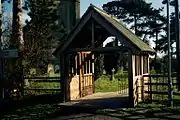 Millennium lychgate at Lenton, Lincolnshire
Millennium lychgate at Lenton, Lincolnshire A rare Scottish example at Cummertrees, Dumfries and Galloway
A rare Scottish example at Cummertrees, Dumfries and Galloway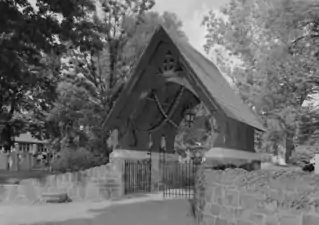 Lychgate at the Church of St. James the Less, Philadelphia
Lychgate at the Church of St. James the Less, Philadelphia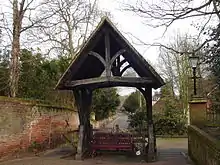 Lychgate at St. Michael's church, Aylsham, Norfolk
Lychgate at St. Michael's church, Aylsham, Norfolk Lychgate of All Saints Parish Church, Shiptonthorpe, East Yorkshire
Lychgate of All Saints Parish Church, Shiptonthorpe, East Yorkshire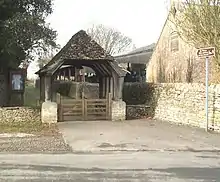 Lychgate at St.Mary's parish church, Castle Eaton, Wiltshire
Lychgate at St.Mary's parish church, Castle Eaton, Wiltshire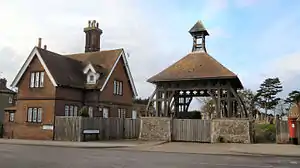 Lychgate at Kirkley Cemetery, Lowestoft, Suffolk
Lychgate at Kirkley Cemetery, Lowestoft, Suffolk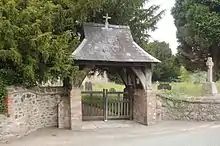
 Early 20th-century lychgate at St Andrew's Church, West Tarring, West Sussex
Early 20th-century lychgate at St Andrew's Church, West Tarring, West Sussex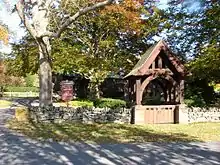 Lychgate at St. Columba's Chapel (Middletown, Rhode Island)
Lychgate at St. Columba's Chapel (Middletown, Rhode Island)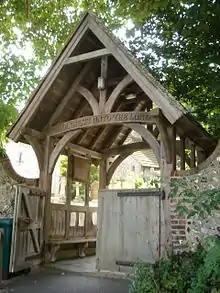 Lychgate at St Wulfran's Church, Ovingdean, East Sussex
Lychgate at St Wulfran's Church, Ovingdean, East Sussex Lychgate at St. Anne's Chapel (Fredericton), New Brunswick
Lychgate at St. Anne's Chapel (Fredericton), New Brunswick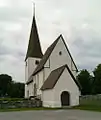 Lychgate at Alskog Church, Gotland (Sweden)
Lychgate at Alskog Church, Gotland (Sweden)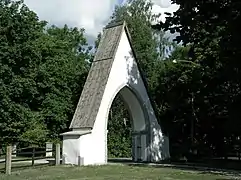 Lychgate at Garde Church, Gotland
Lychgate at Garde Church, Gotland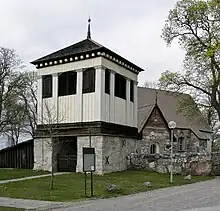 Combined lychgate and bell tower at Rö Church, Sweden
Combined lychgate and bell tower at Rö Church, Sweden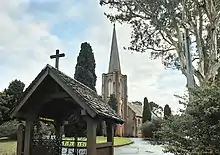 The Anglican Church of St John the Evangelist & its Lych Gate, Camden, NSW 27 Feb 2017
The Anglican Church of St John the Evangelist & its Lych Gate, Camden, NSW 27 Feb 2017
 Lychgate of the St Swithun's Church, Bournemouth
Lychgate of the St Swithun's Church, Bournemouth
See also
References
- This article incorporates text from a publication now in the public domain: Chisholm, Hugh, ed. (1911). "Lich-Gate". Encyclopædia Britannica (11th ed.). Cambridge University Press.
- ↑ "the definition of lich gate". Dictionary.com. Retrieved 6 April 2018.
- ↑ Jarvis, Dale. "More (yes more) on Newfoundland Lych Gates for #MortuaryMonday". Retrieved 2020-06-28.
- ↑ Jeane, D. Gregory; Deetz, James (1989), Meyer, Richard E. (ed.), "The Upland South Folk Cemetery Complex:: Some Suggestions of Origin", Cemeteries Gravemarkers, University Press of Colorado, pp. 107–136, ISBN 978-0-87421-160-3, JSTOR j.ctt46nqxw.11, retrieved 2020-06-28
- 1 2 Jordan, Terry G. (1980). ""The Roses so Red and the Lilies so Fair": Southern Folk Cemeteries in Texas". The Southwestern Historical Quarterly. 83 (3): 227–258. ISSN 0038-478X. JSTOR 30241035. PMID 11633245.
- ↑ Pritchett, R. T. (1878). "Norway. Chapter XVII". The Art Journal. 4: 168–171. doi:10.2307/20569228. ISSN 2152-243X. JSTOR 20569228.
- ↑ Curl, James Stevens; Wilson, Susan (2016). Oxford Dictionary of Architecture. Oxford University Press. p. 454. ISBN 978-0-19-967499-2.
- ↑ Jarvis, Dale Gilbert (2013). "Newfoundland Lych Gates". The Newfoundland Ancestor. 29 (2): 64–67.
- 1 2 Brewer's Britain and Ireland, compiled by John Ayto and Ian Crofton, Weidenfeld & Nicolson, 2005, ISBN 0-304-35385-X
- ↑ Historic England. "St Cuthbert's (1393517)". National Heritage List for England. Retrieved 15 October 2020.
- ↑ "Felkirk". War Memorials Online.
- ↑ Veillette, John; White, Gary (1977). Early Indian Village Churches: Wooden Frontier Architecture in British Columbia. Vancouver: U of BC P. p. 90. ISBN 9780774800754.
- 1 2 Tyack, George S. (1899). Lore and Legend of the English Church. London: William Andrews & Co. p. 67.
- 1 2 Dyer, T.F. Thiselton (1892). Church Lore Gleanings. London: A.D. Innes and Co. pp. 153–154.
- ↑ Laing, Alex. (1891). "Replies to Queries". The Scottish Antiquary, or, Northern Notes and Queries. 6 (21): 46–48. ISSN 2042-0013. JSTOR 25516421.
- ↑ "Lych-gates in Newfoundland :: ICH - Other Materials". collections.mun.ca. Retrieved 2020-06-28.
- ↑ Hedfors, Per (2004). "Considering the Authenticity of the Garden Soundscape: Preliminary Research Based on Interviews". Garden History. 32 (2): 281–284. doi:10.2307/4150388. ISSN 0307-1243. JSTOR 4150388.
External links
- A restoration of a lych gate at Houghton-le-Spring's Hillside Cemetery
- Horsham's Denne Road Lych Gate featuring a traditional lychgate
- Otterbourne lychgate
- Illustrated article on lych gates in Newfoundland, Canada